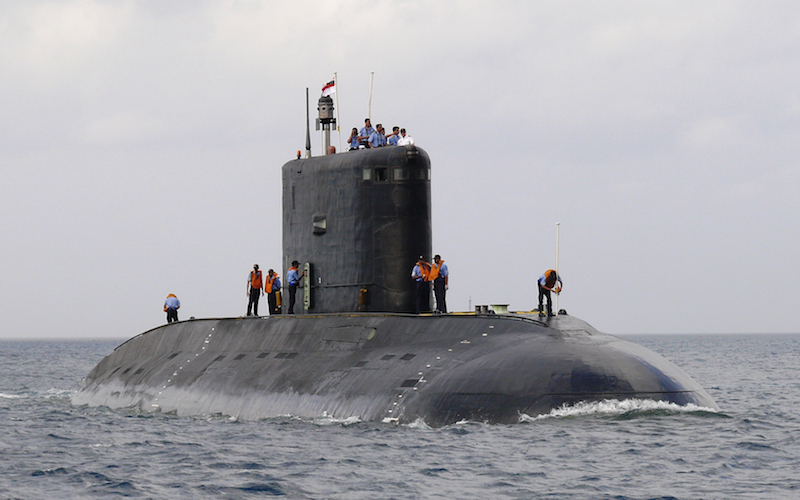
Assessing India’s Nuclear Capabilities
India’s offensive nuclear capabilities are coming of age with sea-trials for its first ballistic missile submarine. The INS Arihant is expected to be introduced into service by early 2015. New Delhi plans to field between four to six similar vessels by the end of 2025 to boost its second strike capability. Pakistan is also likely to develop sea-based nuclear capabilities. Both foes are seeking to develop their own version of the nuclear triad, which incorporates air, land and sea-based systems. Some scholars have argued that second-strike capability will have a positive influence on strategic stability in the region while others have raised concerns about the dangers of a nuclear arms race. And considering the history between India and Pakistan, there is real concern that the next shooting war could spiral out of control.
For India, sea-based nuclear weapons have a credible second-strike nuclear deterrence. Nuclear submarines are capable of lurking undetected and are nearly invulnerable to even the most modern anti-submarine warfare measures. They offer a qualitative advantage to a country’s ability to retaliate after absorbing a nuclear first strike. This will dissuade an adversary, in India’s case, Pakistan, from attempting a dangerous preemptive nuclear attack.
India’s nuclear doctrine draft in 1999 envisioned the necessity for an assured survivable deterrent capability by developing and maintaining credible minimum deterrence based upon a strategic triad of nuclear forces. Threats from both China and Pakistan prompted India to work towards this goal.
India’s rise as a naval power has been in part a reaction to Pakistan, but also China’s “blue water” aspirations where by it feels threatened by the regional superpower. Beijing strategists, on the other hand, see the Indian nuclear ballistic missile submarine capability as threatening to its access to the Indian Ocean through the Malacca Strait, where eighty percent of China’s oil trade takes place. India could use its submarine to block Chinese oil imports through the strait, thereby causing major disruption in the Chinese economy.
For Pakistan, the rationale for developing a naval nuclear capability is to acquire second-strike capability against India and this would also provide the country with greater strategic depth. In 2012 Pakistan inaugurated its Naval Strategic Force Command (NSFC). The navy is being integrated into the country’s command and control structure, which is dominated by the army.
Pakistan’s financial constraints prevent it from acquiring a sea based nuclear deterrent. Pakistan has no plans to deploy nuclear propelled submarines over the next few decades. Instead, naval planners have focused on acquiring more sophisticated conventional submarines, like the recently announced purchase of six Chinese built submarines, and equip them with Babur cruise missiles.
Regarding the submarine purchase from China, a senior Pakistani official told Jane’s, “the contract is in an advanced stage and discussions will not linger on for too long. Realistically, we should have a deal by the end of 2014.” In this way Pakistan can offset India’s increasingly conventional advantage in the Indian Ocean, much in the same way it managed to balance India’s conventional advantage on land.
Both countries, however, need highly secure command and control system for sea-based systems. There is a strong possibility that submarines can lose contact with their bases, leaving the submarine officials to decide about the use of nuclear weapons during a crisis. To prevent the unauthorized or accidental use of nuclear weapons, India and Pakistan have been keeping the warheads separate from their delivery systems.
Nuclear arsenals at sea also increase the risk of terrorist elements getting hold of these weapons. The international community is particularly concerned about the safety and security of Pakistan’s nuclear weapons due to its culture of political instability and extremism. There are several examples in which Pakistan’s naval forces were attacked by terrorist groups.
The lack of political will has prevented India and Pakistan from averting an arms race, both conventional and now nuclear. It is important for both countries to enhance strategic stability by reducing reliance on nuclear weapons and taking measures to reduce their nuclear arsenals. India-Pakistan relations have long been cleaved by deep antagonism, repeated military crises, and a costly arms race. Both countries have rarely interacted in a non-hostile political sphere and the presence of non-state actors has further exacerbated the situation. In order to avoid catastrophic misinterpretation it is essential to negotiate arms control agreements and increase transparency through exchanging information and signaling intent to improve strategic and crisis stability.

